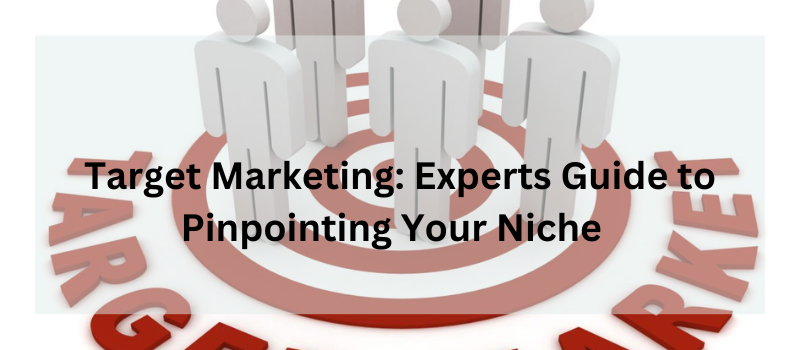Target marketing is the holy grail of marketing. In a world flooded with generic messaging and mass-marketed products, finding your niche and speaking directly to their needs is the key to standing out.
This guide will walk you through how to conduct surgical-precision market research, take aim at your target audience’s bull’s eye, fire away with tailored tactics, and continually refine your approach. Equipped with these secrets, you’ll be able to zero in on your niche with eagle-eye accuracy.
Contents
- 1 Segment Your Target Marketing for Effective Advertising
- 2 Lay the Groundwork for Precision Targeting
- 3 Take Aim at Your Audience Bull’s Eye
- 4 Fire Away with Tailored Marketing Tactics
- 5 Continually Refine Your Approach
- 6 FAQ’s
- 6.1 Q1: What are the benefits of precise target marketing?
- 6.2 Q2: How do you identify the best target market?
- 6.3 Q3: What methods help refine target marketing approach?
- 6.4 Q4: How can you ensure messaging appeals to niche?
- 6.5 Q5: What metrics indicate effective target marketing?
- 6.6 Q6: How often should you reevaluate target markets?
- 7 Conclusion:
Segment Your Target Marketing for Effective Advertising

In a crowded marketplace, generic mass marketing is like firing a shotgun blindly into the darkness. You might hit something, but it’s imprecise and wastes resources. To hit your target and generate a return, you need a sniper’s focus.
That’s where market segmentation comes in. By dividing your audiences into subsets with common needs and traits, you can tailor your advertising and messaging to resonate like a bullseye.
Demographic Segmentation Opens Doors
Demographic factors like age, income, ethnicity, location and more provide intuitive ways to group your broader market. Let’s explore how to attract each demographic segment through targeted advertising.
Income Level Allows Personalization
Income is a major driver of consumer behavior. Create tailored value propositions for people at different income levels. For lower income consumers, develop gift guides showcasing products under $20. Emphasize affordability and necessities.
For middle income families, share money-saving tips and recommend mid-range products that balance quality and price. Families seeking value respond well to bargains and sales.
High income earners present opportunities to promote premium offerings and luxuries. Highlight superior craftsmanship, exclusivity and elite status when marketing to this group.
Adapt to Family Status
Life stage is closely linked to consumer needs. Tap into the family niche with products personalized for dads, husbands, wives, new parents. Segment further by age of children.
Target empty nesters with cruise packages and retirement investment plans. College students need dorm room essentials and academic planners. Newly married couples will appreciate registry gift ideas.
Generational Preferences Inform Strategies
Generational cohorts like Baby Boomers, Gen X, Millennials or Gen Z have distinct experiences that shape their preferences.
Emphasize traditional values and classic styles when marketing to Baby Boomers. Gen X may respond better to convenience-oriented and career-focused messaging. For Millennials and Gen Z, prioritize digital experience, causes, and shareable content.
Psychographic Segmentation Makes Connections
Psychographic segmentation divides groups based on psychological traits like attitudes, values, interests and lifestyles. Let’s look at how to best resonate with various psychographic segments.
Appealing to consumers’ values is powerful for forging emotional connections. Environmentally-conscious shoppers will favor eco-friendly positioning. Nationalistic messaging resonates with patriotic segments.
Religious consumers respond when you reflect their faith-based values. Community-oriented positioning works for collectivist cultures. Values-aligned branding builds loyalty.
Interests Inspire Engagement
Relevant messaging based on niche interests captures attention. Sponsor sports teams and highlight players that fans are devoted to. Enable hobbyists to share their passion through branded communities.
Gamers will engage with gaming gear and apparel collateral. Pet owners connect with pet-centric products and content. Aligning with niche interests builds trust.
Opinions Attract Advocates
Carefully consider how to address controversial issues and topics to avoid alienating potential segments. Reinforce shared beliefs to gain advocates.
But avoid taking polarizing stances that isolate those with differing views. Seek common ground and inclusive messaging where possible.
Shopping Habits Enable Convenience
Shopping motivations and habits are prime for segmentation. Bargain hunters will appreciate price comparisons and coupons. Impulse purchasers respond to flash sales and immediate discounts.
Loyalty program perks attract regular patrons. Convenience-driven buyers favor apps and fast checkout. Meet shoppers where they are for maximum impact.
Lay the Groundwork for Precision Targeting

Before pulling the trigger on your marketing efforts, you need to thoroughly understand your environment and identify opportunities. Rushing into a campaign without doing your homework will leave you firing blind. Follow these steps to set yourself up for a precise strike:
Conduct Thorough Market Research to Identify Potential Targets
Don’t go into battle without knowing the lay of the land. Take time to analyze industry data, trends and projections so you can make informed decisions about where opportunities exist. I’d recommend exploring resources like IBISWorld, Mintel and Forrester. You’ll get insights into growth projections, technological disruptions, regulatory changes, competitive forces and more.
It’s also incredibly valuable to learn from your competitors’ target markets. Study their positioning and messaging for clues on how they are segmenting the audience. You may find gaps where competition is falling short in meeting customer needs.
But your most valuable intel will come straight from the source – your potential customers. Make an effort to survey prospective users to gain first-hand insights on their pain points and desires. This primary research is like gold and will fuel your targeting efforts.
Build Detailed Buyer Personas to Intimately Understand Your Ideal Customers
Once you’ve identified promising target segments, it’s time to get up close and personal through buyer personas. These fictional representations of your ideal customers will become your secret weapon.
Pour over data on demographics like age, gender, income, location, education level, and occupation. Go deeper by adding psychographic dimensions – what are their values, priorities, interests, attitudes, and lifestyles?
Most importantly, outline their needs, frustrations, and desires. What keeps them up at night? Where are they underserved? What are they seeking? An intimate understanding here will allow you to craft messaging that resonates deeply.
Take Aim at Your Audience Bull’s Eye

You’ve identified and intimately researched your prospects. Now it’s time to develop a laser focus on the segment that presents the ripest opportunity. Keep these tips in mind as you take aim:
Laser Focus Your Messaging to Align with Your Target Customer Interests
With a keen understanding of your well-defined niche, you can now craft messaging and positioning tailored specifically to them. Highlight benefits that will resonate given their priorities, and use language that will strike an emotional chord based on their values. Address the pain points and desires you uncovered through your research. Your copy should sound like it was written expressly for that one audience segment.
Ensure Product-Market Fit by Addressing Your Niche’s Pain Points
Carefully assess whether your offering is positioned to alleviate the top frustrations of your target market. If not, consider how to pivot your product roadmap or marketing emphasis to achieve product-market fit. No amount of great marketing will help if your solution doesn’t directly address your niche’s struggles. Satisfying their needs should remain your north star.
Prioritize Targets with the Greatest Need for Your Offerings
As you take aim, prioritize segments where demand appears highest and your solution aligns strongly to needs. Analyze which niches have the most intense pain points. Look for gaps where the competition is failing. Pursue the underserved segment whose challenges most closely match your offerings. They will have the greatest incentive to embrace you.
Fire Away with Tailored Marketing Tactics
Now comes the fun part – executing a strategic marketing plan tailored to resonate with your clearly defined target. With the prep work done, it’s time to fire on all cylinders.
Customize Positioning and Branding to Resonate with Your Niche
Consistency is key, so align your positioning and branding closely to the identity of your target segment. Develop messaging that speaks to their priorities and values. Select imagery and language that will feel familiar. Your branding should act as a symbol of their identification with the niche you are speaking to directly.
Develop Content That Speaks to Your Target Audience’s Concerns
Leverage your insights into your niche’s pain points to create content that addresses their struggles and educates them on solutions. Your brand will be positioned as an authority and advocate. Consider developing use cases and customer testimonials from others in the target segment to build trust.
Select Marketing Channels Where Your Targets Are Actively Engaged
Get strategic about where you aim your marketing dollars by investing into the platforms and venues where your niche is concentrated. Prioritize ad spending on the social media sites they frequent. Attend their industry conferences and events. The more saturated you are in their channels, the better.
Track Conversion Rates to Measure Your Targeting Accuracy
It’s important to monitor key conversion metrics to quantify your marketing effectiveness. Are prospects engaging with your ads? Converting to sales? Referring others? Optimization is critical. Continuously assess performance by channel and double down on those producing the highest ROI.
Continually Refine Your Approach
Precision targeting isn’t a one-and-done effort. To achieve long-term dominance, you must stay agile and keep refining your approach. Here are some tips:
Use Behavioral Data and Surveys to Refine Your Understanding of the Target
Check your assumptions through data. Track site analytics to reveal how your niche engages with content, so you can better cater to their preferences. Run A/B tests to identify the messaging that resonates most. Survey customers to get feedback on improving your focus.
Monitor Market Trends to Assess if Your Niche is Changing
Markets are dynamic, and niches evolve over time. It’s critical to stay on the pulse through Google Alerts, industry reports, and newsletters. Update personas and targeting approaches in response to any market shifts. Keep a finger on the niche’s pulse.
Pivot Your Prioritization as Needed to Pursue Shifting Opportunities
Be ready to change course if your initial niche becomes saturated or stagnant. Keep a close watch for emerging customer segments where you can get a first-mover advantage. Divert resources to where you spot market gaps before competitors do. Stay nimble.
Stay Agile and Keep Your Aim Razor Sharp on Your Niche
Complacency will dull your targeting edge. Continuously gather updated market intelligence so you can reassess frequently. The day you stop learning about your niche, your advantage begins to recede. Keep your approach flexible, your weapon loaded and take aim at the next opportunity.
FAQ’s
Q1: What are the benefits of precise target marketing?
A: Laser-focused targeting leads to higher conversion rates, lower customer acquisition costs, strong brand loyalty, and sustainable competitive advantage in a chosen niche.
Q2: How do you identify the best target market?
A: Conduct thorough market research, create detailed buyer personas, analyze competitors, and survey prospective customers to gain insights into optimal segments.
Q3: What methods help refine target marketing approach?
A: Behavioral data analysis, A/B testing content, ongoing market research, updating personas, shifting priorities to pursue new opportunities.
Q4: How can you ensure messaging appeals to niche?
A: Use intimate knowledge of niche pain points and values to craft messaging tailored to their priorities and emotionally resonate.
Q5: What metrics indicate effective target marketing?
A: Track engagement, conversions, referrals, lifetime value and optimize tactics to channels driving highest ROI.
Q6: How often should you reevaluate target markets?
A: Continuously gather updated intelligence and reassess at least quarterly to keep your approach razor-sharp and adjust to market shifts.
Conclusion:
Laser-focused targeting may seem like a lofty aspiration, but with the right approach, it’s an achievable skill that delivers tremendous upside. By taking the time to intimately understand your niche, customized messaging and experiences can be crafted to form an unbreakable bond rooted in shared values and priorities.
Savvy marketers who master precision targeting reap game-changing benefits like higher conversion rates, reduced customer acquisition costs, passionate brand evangelists, and sustainable competitive barriers.
The dividends are well worth the investment. So hone your skills, scope your landscape, and zero in on your target for the ultimate bullseye.
Get Started Segmenting Your Audience
Read More:
Innovative Ideas to Launch Your Ecommerce Store Without Competitors | Made Online Selling Easy



